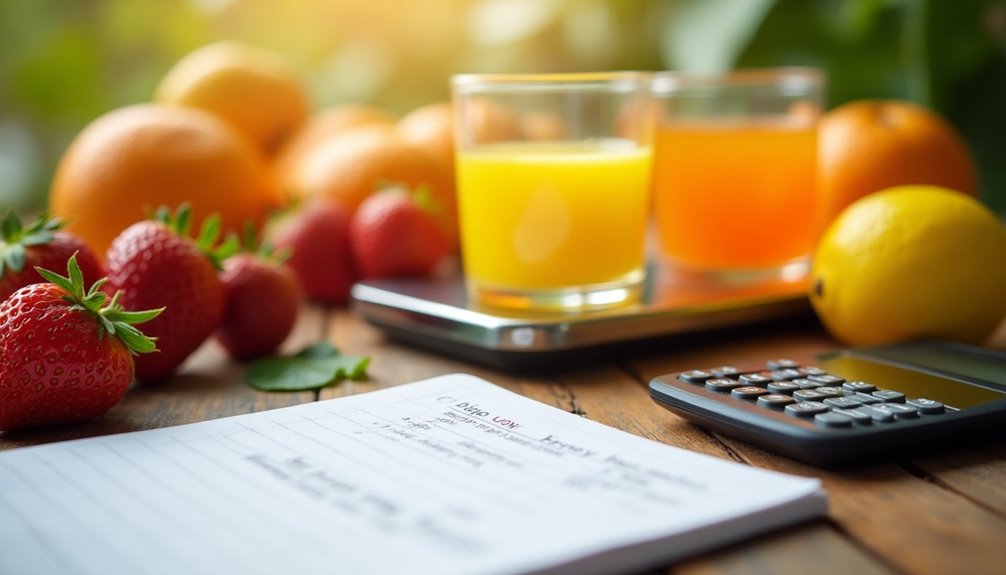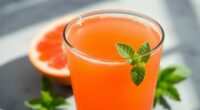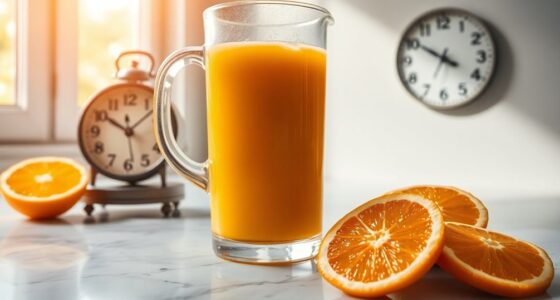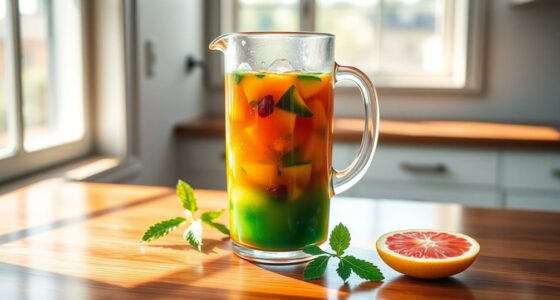To calculate juice cost, gather the weights and prices of all ingredients in your recipe, like apples and oranges. Add up these costs to find the total. Next, divide that total by the number of servings you produce. Remember to monitor ingredient prices regularly, as they can fluctuate and affect your profit margins. Aiming for a food cost percentage under 20%-25% of your selling price is key. You'll discover more tips for optimizing your juice cost strategy!
Key Takeaways
- Gather ingredient weights and pricing from local distributors to establish a cost foundation for your juice recipe.
- Calculate the total recipe cost by summing ingredient prices, considering the yield from the produce used.
- Determine the cost per serving by dividing the total recipe cost by the number of servings produced.
- Monitor ingredient prices regularly to account for fluctuations and adjust pricing strategies accordingly.
- Set a selling price that maintains a profit margin, ensuring food costs remain under 20%-25% of the selling price.

Calculating juice cost can seem daunting, but with a clear approach, you can manage it effectively. The first step in calculating juice cost is figuring out the weight of each ingredient in your recipe. You'll want to gather current pricing from local distributors or grocery stores to ensure your numbers are accurate. For example, if you're using apples, oranges, and ginger, note their respective weights and prices. This will set the foundation for your entire cost calculation.
Once you've gathered the weight and price per ingredient, it's time to add them up to find your total recipe cost. Don't forget to consider the yield when calculating. Generally, you'll need about 1.6 lbs of produce to produce 16 oz. of juice. This means if your recipe calls for a total of 3.2 lbs of produce, you can expect to yield approximately 32 oz. of juice. Understanding yield is crucial because it directly impacts your cost per serving.
To find your cost per bottle of juice, you’ll need to divide the total recipe cost by the number of servings. For instance, if your total recipe cost is $5 and your yield is 32 oz. , which translates to two 16 oz. bottles, your juice cost per bottle would be $2. 50. This simple division helps clarify how much you’re spending on each serving and gives you a clearer picture of your pricing strategy. You can use this cost per bottle to evaluate your overall pricing strategy and ensure you’re operating profitably. Additionally, it’s essential to consider other potential costs, such as packaging and distribution, which can affect your final price point. To further refine your pricing, you might conduct a pocket juice charger price comparison to understand how your costs align with similar products on the market, allowing you to position your juice competitively.
As you work through your calculations, keep an eye on ingredient pricing. Prices can fluctuate based on seasonality and market conditions, and these changes can significantly affect your overall juice cost. Regularly tracking these fluctuations allows you to adapt your pricing strategy to maintain profitability. If your ingredient prices rise, you might need to adjust your selling price to ensure you aren't losing money on each bottle sold.
When setting your selling price, aim to keep your food cost percentage under 20%-25% of the price. For instance, if you're selling a bottle of juice for $10, your ingredient cost should ideally not exceed $2.50. This approach helps you maintain a healthy profit margin, ensuring that your juice production operation remains sustainable.
Frequently Asked Questions
How Do I Price My Juice?
To price your juice effectively, start by assessing the total cost of your ingredients and packaging.
You'll want to keep food costs between 20%-30% of your juice price for profitability.
Remember that each juice type should reflect its unique production costs, avoiding a one-size-fits-all price.
Regularly check ingredient prices and adjust your pricing accordingly to adapt to market changes, ensuring you maintain a fair profit margin while keeping customers satisfied.
How Is Juice Calculated?
You might think calculating juice is straightforward, but it involves more than just mixing ingredients.
You'll need to assess the weight of each component and their prices from local suppliers. By summing these costs, you can find the total for your recipe.
Then, divide that by the number of bottles produced to get a clear food cost per bottle. Keeping track of ingredient prices is essential to maintain profitability in your juice business.
What Is the Profit Margin on Juice?
The profit margin on juice typically ranges from 40% to 60%.
To determine your margin, you'll need to assess your selling price and the cost of goods sold. For example, if you're selling a bottle for $10 and it costs you $4 to make, your profit margin would be 60%.
Keep an eye on ingredient costs and adjust your prices as needed to maintain those healthy margins and ensure your business thrives.
How Do You Calculate Juice Content?
To calculate juice content, you'll first weigh each ingredient in your recipe.
Remember, each pound of produce usually yields about 10 ounces of juice. For a standard 16-ounce bottle, you'll need around 1.6 pounds of produce.
Use the formula: Total Juice Content = (Total Weight of Ingredients) x (Juice Yield Ratio).
It's essential to conduct trials to determine your precise yield for consistent results, adjusting your recipes as needed.
Conclusion
Now that you know how to calculate juice cost, you can confidently manage your expenses and maximize your profits. Remember, every ounce counts—how much are you really spending per glass? By keeping track of your ingredient costs and production methods, you'll not only ensure quality but also make smarter business decisions. So, grab your calculator and start crunching those numbers to see the true value of the juice you're serving!
Cindy thoroughly researches juicing trends, techniques, and recipes to provide readers with practical advice and inspiration. Her writing style is accessible, engaging, and designed to make complex concepts easy to understand. Cindy’s dedication to promoting the advantages of juicing shines through her work, empowering readers to make positive changes in their lives through the simple act of juicing.











